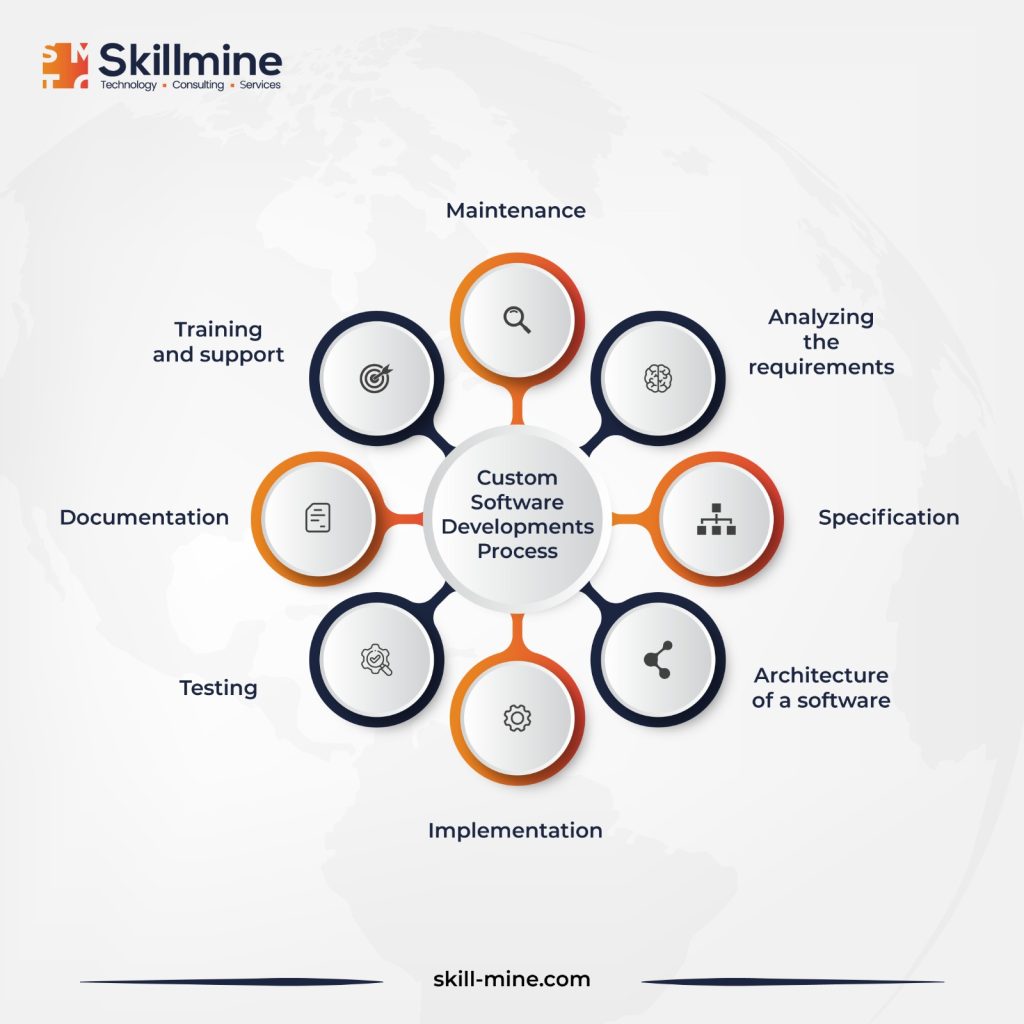In the first quarter of 2023, users downloaded approximately 27 billion apps from Google Play. The global custom software development market size was valued at USD 29.29 billion in 2022 and is expected to expand at a compounded annual growth rate (CAGR) of 22.4% from 2023 to 2030.
Custom software development refers to the intricate procedure of designing software solutions tailored to fulfil the precise requirements of a specific organization or business. This multifaceted process encompasses several stages and demands proficiency in a range of technologies.

Let’s understand some of the custom software development best practices.
Document every stage of development
Thoroughly analyzing the scope and planning requirements ensures that every aspect meets your desired standards. Once you’ve defined your needs, comprehensive documentation becomes a crucial factor throughout all stages of development and implementation.
Ensure you have:
- A well-structured test design and checklist to guarantee thorough software vetting.
- A clear statement of scope to focus exclusively on pre-defined deliverables.
- An implementation plan that outlines timelines and user roles.
- User documentation featuring frequently asked questions (FAQs).
Keep an eye on your budget
Establish the development budget and select the appropriate pricing model. Listed below are the factors that influence potential development expenses:
1. The number of work hours required for solution development, which is dependent on:
- The level of complexity
- The functionalities and features
- Product design and UI/UX
- The chosen platform(s)
2. The hourly rate, which can vary based on:
- The geographical location of the development partner
- The specific skills or type of developers needed
3. The monthly/annual costs associated with 3rd party APIs and tools to be employed, such as fees for cloud services, web and domain hosting, and SSL certificates, among others.
4. A contingency allowance of 20%-30% of the total cost to accommodate unforeseen circumstances and unexpected expenses.
Hire the right team of professionals
Assembling a team of skilled professionals is a critical step towards accomplishing your overarching goals and realizing your vision for a successful product. The most dependable method for creating high-quality custom software involves entrusting your project to a custom software development company. When finalizing your choice of a custom software development company, it’s important to consider the following:
- The company’s website and its historical background.
- The physical location of the company.
- The company’s size and infrastructure.
- The domain expertise they possess.
- References and reviews from previous clients.
- Their approach to security and intellectual property protection.
Choose the right technology stack
Harnessing the potential of the right technologies in the development process is crucial for long-term success. This encompasses programming languages, frameworks, libraries, and various development tools employed in the creation and operation of your product. Therefore, it’s essential to define these components in advance to assemble the ideal team of experts. It’s important to note that relying solely on your competitors’ technology stack may not be the best approach.
Here are four key parameters to consider when selecting the most suitable technology stack for web development:
- Ultimate Product – Clearly define the product’s usability, target users, and expected impact.
- Platforms – Determine whether the product will be a web application, mobile app, desktop application, or a combination of these.
- Development – Choose stable technologies and complementary tools that can expedite the development process.
- Talent Pool – Opt for technologies that are commonly used by most developers, making it easier to hire them at a more cost-effective rate.
Set realistic milestones
To ensure the realization of your desired product, it’s essential to establish a well-structured plan with attainable milestones. Your next task is to define these milestones, which serve as checkpoints to keep you accountable and on course. These milestones represent various phases of the development process, each with a designated timeframe and budget. Here’s what you need to do:
- Develop an effective plan.
- Outline the desired workflows.
- Create a comprehensive roadmap for implementation, considering factors such as time and budget.
- Define project success criteria that are agreeable to end-users, customers, and stakeholders.
- Execute the development work.
- Review progress at each scheduled milestone.
- Collect feedback from stakeholders and immediate users at each stage.
- Identify areas that require improvement.
Choose the right methodology/ SDLC
The Software Development Life Cycle (SDLC) represents the methodology employed in the development process of any software development company. It comprises a series of tasks that must be completed at each stage, and below are the two most prevalent types:
1. Agile Methodology: The agile development cycle does not follow a linear path; instead, it is iterative. Each iteration leads to a functional product release and closely monitors the work accomplished at a granular level.
PROS | CONS |
Product goals are defined by stakeholder | Requires considerable expertise and discipline |
Strong collaboration | Planning may be weak |
Active customer feedback mechanism | Timing must be very clear for tracking |
Adaptive and flexible to changes | Requires dedicated skilled resources |
Rapid and outcome-driven | The final product may be entirely different from the expectations |
2. The Waterfall Model: If you are confident that your requirements accurately represent the desires and needs of your end-users and your assumptions are accurate, then the Waterfall model is the suitable choice.
PROS | CONS |
Clear, thorough documentation and planning. | Documentation takes a huge amount of time. |
Simple to follow, implement and manage. | Incapable of intense support and maintenance. |
Quick to accomplish; Timely delivery. | Delivery only at the end. |
Fixed cost and predictability. | Modifying the requirements during development is highly challenging. |
A strong, disciplined process. | Less flexible; No room for process changes or simultaneous workflow. |
Conduct Thorough Quality Assurance, Testing, and Security Checks
Custom software demands minimal errors when it’s deployed for use. Achieving this goal necessitates consistent quality assurance and testing. The most critical step is evaluating the software’s adaptability across various environments once the software application is developed and ready for business use.
Even in the early stages of development, testing is an integral component that should be considered to:
- Monitor the evolution and resolution of every identified bug.
- Prevent any errors or failures.
- Allocate sufficient time for necessary corrections.
Before launching the product, subjecting an application to comprehensive testing using all essential parameters ensures seamless performance across diverse devices and browsers. To safeguard all data and information, scrutinize each element and logic, and review the security certificates and encryption.
Testing typically occurs at two levels:
- Technical Testing: QA professionals evaluate the performance of foundational components by conducting tests under various scenarios and on multiple devices to ascertain if they align with expectations.
- User Testing: Beta (actual) users assess whether the software operates as anticipated and intended and report any issues they encounter.
Conclusion
Custom software development is an intricate process, that demands proficiency in various technologies. It necessitates thorough planning and the perfect blend of expertise and experience to bring the project to fruition successfully. When contemplating custom software development, collaborating with a reputed team becomes imperative. Skillmine brings industry-specific experience to the table, ensuring that your custom software solution is tailored to your unique needs.
Looking for expert technology consulting services? Contact us today.





